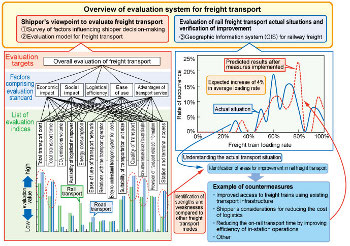26. Railway Freight Transport Evaluation method
Efforts to improve the efficiency of freight transport are becoming increasingly urgent in an era where global warming has become a key societal issue, compounded by low birth rates & an aging population. Therefore, a systematic evaluation method for freight transport was developed, not only to evaluate the economic efficiency and effectiveness of freight transport, but also to provide an overall visual representation of freight train loading conditions (Figure 1).
Based on the knowledge, viewpoints and expertise of logistics professionals, such as shippers, a quantitative evaluation model was built, with 13 related index items covering 5 aspects generally considered by logistics managers, which were each weighted with the responses to an online questionnaire data. The model offers a holistic assessment of freight transport, allowing comparison of rail and road freight transport options and highlighting comparative drawbacks in rail transport in relation to the road. This information can then in turn be used to devise measures to improve railway freight efficiency.
Railway Freight Geographic Information System (RF-GIS) was developed to provide a visual evaluation system of the loading conditions of freight train, based on train diagram data and actual freight loading & unloading operation schedules. Such the system provides a clear view of the loading conditions of freight train on each route from departure terminal to destination station.
This evaluation model and RF-GIS allow visualization of the current state of traffic and loads on the freight network, which in turn can serve to design targeted measures to improve rail transport efficiency, such as increasing accessibility to freight trains, etc.

